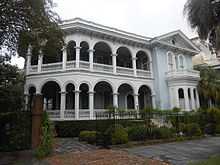Edward C. Jones
From Wikipedia, the free encyclopedia

The John Ashe, Jr. House at 26 South Battery, Charleston, South Carolina
Edward C. Jones (1822-1902)[1] was an American architect from Charleston, South Carolina.[2] A number of his works are listed on the U.S. National Register of Historic Places, and one is further designated a U.S. National Historic Landmark. His works include the following (with the first eight being NRHP-listed works):[3]
- Farmers' and Exchange Bank (designed 1853, completed 1854), 141 East Bay St., Charleston, South Carolina, a National Historic Landmark
- Magnolia Cemetery (1850), 70 Cunnington Ave., Charleston, South Carolina
- Old Colleton County Jail, Jeffries Blvd., Walterboro, South Carolina
- Orangeburg County Jail, 44 Saint John St., Orangeburg, South Carolina (with Francis D. Lee)
- South Carolina National Bank of Charleston, 16 Broad St., Charleston, South Carolina
- St. Mark's Church, W of Pinewood on SR 51, Pinewood, South Carolina
- Walker Hall, SE of Spartanburg on SC 56, Spartanburg, South Carolina
- Wofford College Historic District, Wofford College campus, Spartanburg, South Carolina
- Trinity Methodist Church (1848), 273 Meeting St., Charleston, South Carolina
- Vigilant Fire Engine House, State St., Charleston, South Carolina
- Moultrie House (1850), a hotel on Sullivan's Island, South Carolina, no longer standing
- Roper Hospital (1849), Queen St., Charleston, South Carolina, no longer standing
- Col. John Algernon Sydney Ashe House (1853), 26 South Battery, Charleston, SC
- New Work House (a colored prison), southwest corner of Magazine and Logan Sts., no longer standing
- Church of the Holy Cross (1850), Statesburg, SC
- Marlboro County Courthouse (1850), Bennettsville, SC
- Palmetto Fire Co. (1850), 27 Anson St., Charleston, SC
- Aiken House (1851), a hotel in Aiken, SC (no longer standing)
- Shell Hall Hotel, Mt. Pleasant, SC (no longer standing)
- Bank of Augusta (1852), Augusta, GA
- Zion Presbyterian Church, Calhoun St., Charleston, SC (no longer standing)
- Flat Rock (Farmers') Hotel, Flat Rock, NC
- St. John in the Wilderness Church, Flat Rock, NC
- Calvary Church, Fletcher, NC
- Normal School of Charleston, Charleston, SC (no longer standing)
- Friend Street Public School (1859), Legare and Broad Sts., Charleston, SC (destroyed by fire, 1861)
References
- ↑ Catherine W. Bishir (2012). "Edward C. Jones (1822-1902)". North Carolina Architects and Builders: A Biographical Dictionary. Raleigh, NC: Copyright & Digital Scholarship Center, North Carolina State University Libraries.
- ↑ Tray Stephenson and Bernard Kearse (April 19, 1973). National Register of Historic Places Inventory-Nomination: Farmers' and Exchange Bank PDF (32 KB). National Park Service and Accompanying one photo, exterior, undated PDF (32 KB)
- ↑ "National Register Information System". National Register of Historic Places. National Park Service. 2010-07-09.
Further reading
- Hudgins; Carter L., ed (1994). The Vernacular Architecture of Charleston and the Lowcountry, 1670 – 1990. Charleston, South Carolina: Historic Charleston Foundation.
- Jacoby, Mary Moore, ed (1994). The Churches of Charleston and the Lowcountry (hardback). Columbia South Carolina: University of South Carolina Press. ISBN 0-87249-888-3. ISBN 978-0-87249-888-4.
- Moore, Margaret H (1997). Complete Charleston: A Guide to the Architecture, History, and Gardens of Charleston. Charleston, South Carolina: TM Photography. ISBN 0-9660144-0-5.
- Ravenel, Beatrice St. Julien (1904-1990); Julien, Carl (photographs); Carolina Art Association (1992). Architects of Charleston. Columbia, S.C.: University of South Carolina Press. p. 295. ISBN 0-87249-828-X. LCCN 91034126.
- Severens, Kenneth (1988). Charleston Antebellum Architecture and Civic Destiny (hardback). Knoxville: University of Tennessee Press. ISBN 0-87049-555-0. ISBN 978-0-87049-555-7
- Smith, Alice R. Huger; Smith, D.E. Huger (1917). Dwelling Houses of Charleston, South Carolina. New York: Diadem Books.
- Stockton, Robert, et. al (1985). Information for Guides of Historic Charleston, South Carolina. Charleston, South Carolina: City of Charleston Tourism Commission.
- Stoney, Samuel Gaillard (1960). This is Charleston: a survey of the architectural heritage of a unique American city. Carolina Art Association. p. 137.
- Whitelaw, Robert N. S.; Levkoff, Alice F. (1976). Charleston, come hell or high water: a history in photographs. Columbia, S.C.: University of South Carolina Press. p. 89.
- Waddell, Gene (2003). Charleston Architecture, 1670–1860 (hardback) 2. Charleston: Wyrick & Company. p. 992. ISBN 978-0-941711-68-5. ISBN 0-941711-68-4
- Wells, John E.; Dalton, Robert E. (1992). The South Carolina architects, 1885–1935: a biographical dictionary. Richmond, Virginia: New South Architectural Press. ISBN 1-882595-00-9.
- Weyeneth, Robert R. (2000). "Historic Preservation for a Living City: Historic Charleston Foundation, 1947–1997". Historic Charleston Foundation Studies in History and Culture series (University of South Carolina Press). p. 256. ISBN 1-57003-353-6. ISBN 978-1-57003-353-7.
This article is issued from Wikipedia. The text is available under the Creative Commons Attribution/Share Alike; additional terms may apply for the media files.
.jpg)